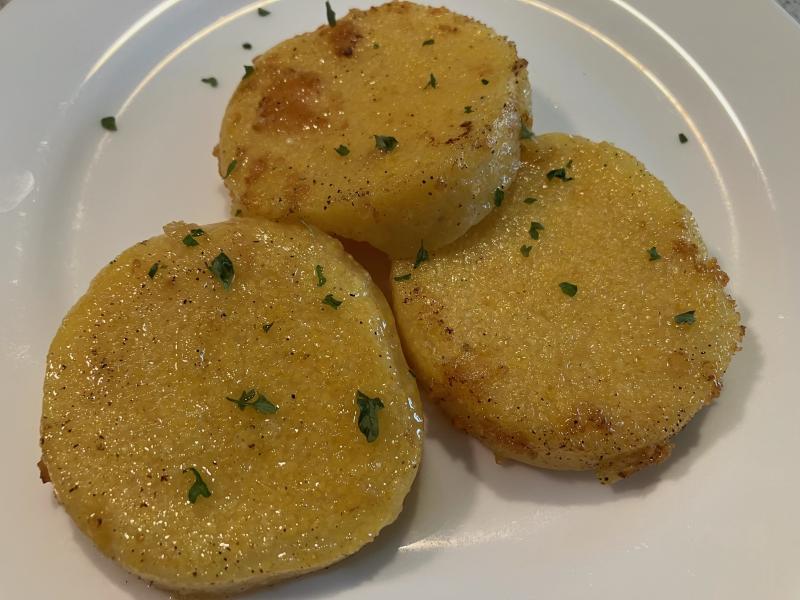Cornmeal is an American contribution to world cuisine
During the past month, I’ve had two different shrimp dishes that shared a common ingredient: cornmeal. In one, the accompaniment was a disk of creamy polenta, and the other featured cheese grits. Since they both come from ground corn, what’s the difference? As it happens, there are quite a few.
If you start with geography, polenta has its origins in Italy, while grits are associated with the southern American states. Another variation is the color, with polenta made from yellow cornmeal while grits are white. This comes from the use of two different types of corn.
Corn is one of the foods truly native to the Americas; it was brought back to Europe by early explorers and is now a familiar food across the world. Originally, the type of corn people ate is what we now call field corn. Due to the hard shell on the kernels, it was not eaten fresh, but cooked into cakes, breads and puddings, or dried and ground into flour. It’s also the type of corn used as animal feed.
Two varieties of field corn are found today. Dent corn, named for the shape it develops when mature, is dried and ground to make the cornmeal for grits. The other type is flint corn, which grows well in cooler climates and is used for polenta. Grits are milled just once, creating pieces that are jagged and irregular, while polenta has a finer texture from multiple milling steps.
When you’re shopping for the ingredients to make either one of these dishes, you may be confused by what is available on grocery shelves. In some cases, you can find stone-ground cornmeal that is fine enough to use for polenta and some that is coarse enough for grits. You may also see Quaker containers marked “old-fashioned” or “quick” grits. The Bob’s Red Mill package of cornmeal is labeled for both grits and polenta. The other way to purchase polenta is precooked in a tube encased in plastic wrap.
The round slices in the photo are from one of those packages, which are usually found in the grocery’s dairy or produce section. When you open the plastic sleeve, be sure to drain out all the liquid and pat dry the exterior, or you won’t get a nice brown crust in the skillet. The flavor can be a bit bland, so I add a sprinkle of pepper and a scatter of Parmesan cheese.
To make polenta from scratch, the cornmeal is simmered with water or broth into a smooth, creamy consistency. Sometimes recipes call for the addition of herbs or cheese to complement how it will be served. The mixture is then poured into a container, typically a loaf pan, and chilled until firm. Slices of polenta are sautéed in butter or olive oil and served alongside the main-course protein.
Grits can be cooked in milk or water and are especially delicious when combined with cheese as a savory side dish. To serve grits for breakfast, they’re simmered until smooth and lump-free, then garnished with butter or syrup at the table. I’ve included recipes for polenta cakes that resemble the ones served with grilled shrimp in a tomato broth, as well as cheese grits that work well in the comfort-food dish of shrimp and grits.
Polenta Cakes*
4 C water
1 1/2 t salt
1 C fine-ground cornmeal
2 oz grated Parmesan cheese
1 T butter
1 T olive oil
Bring water and salt to a rolling boil in a large saucepan over medium-high. While whisking gently, gradually pour in cornmeal in a steady stream. Continue cooking, whisking often, until mixture is thickened, about 10 minutes. Reduce heat to low, cover and continue cooking for 30 minutes, stirring vigorously every 5 minutes to scrape down the sides and keep the bottom from sticking. Once the polenta is cooked, stir in cheese and butter until incorporated. Pour into a loaf pan and smooth the top with a spatula. Allow to cool for 10 minutes, then cover with aluminum foil and freeze for about 40 minutes. Remove the pan from the freezer and run a thin knife along the inside of the pan to loosen. Invert onto a cutting board and cut into 1/2-inch-thick slices. Heat butter and olive oil in a nonstick skillet over medium-high. Place polenta cakes in pan in a single layer. Cook until the bottoms are golden brown and crisp, about 8 minutes. Flip the cakes and cook until golden, about 4 minutes more. Yield: 6 servings. *Adapted from thekitchn.com.
Cheese Grits*
4 C low-sodium chicken broth
1 minced garlic clove
1 C old-fashioned grits
1 1/2 C shredded cheddar cheese
4 T butter
2 T heavy cream
salt & pepper, to taste
Bring the broth to a boil in a deep saucepan over medium high. Add the garlic and slowly add the grits. Reduce heat to low and cook, stirring often, until tender, about 20 minutes. Remove pan from heat and stir in cheese, butter and cream. When mixture is smooth, adjust seasonings to taste with salt and pepper. Serve immediately. Yield: 6 servings. *Adapted from Food & Wine.























































